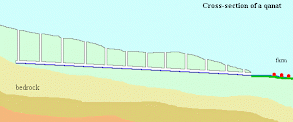Maka
Q926877Maka: satrapy of the ancient Achaemenid Empire, modern Oman.

The name Maka for what is now called Oman is very ancient; in the third millennium, the Akkadians already knew a country called Magan, which, they claimed, had been conquered by their king Naram-Sin (r.2254-2218; ABC 20). Later, it was called Qade by the Babylonians; the Assyrian king Aššurbanipal (r.668-631 BCE) mentions a country Pade with a capital Iski, which must be Izki in Oman. The Persian name Maka is, therefore, an archaism (which is not uncommon in this period).
In the third millennium BCE, the region not only traded with the country of the Euphrates and Tigris, but also with the Indus valley. Many objects from the Harappan culture have been found in Oman. The country appears to have exported copper.

The next millennium, the second, is something of a "dark age". At the end of it, the Makans had invented the qanats, underground drainage galleries that bring water from an aquifer on the piedmont to the gardens or palm groves on the plains. The invention was later copied in Iran.
The first millennium is called the "Iron age" of Oman, but this is actually unjustified, because no iron objects have been found (so far). There are, however, many similarities to Iron age cultures of southern Iran and the valley of the Indus.
Maka was already a part of the Achaemenid Empire in 520 BCE, because it is mentioned in the Behistun inscription. It is possible that it was conquered by Cyrus the Great (r.559-530), who is known to have campaigned on the other side of the Persian Gulf (he seems to have lost an army in the Gedrosian desert).
Maka is also mentioned by the Greek researcher Herodotus, who states that during the reign of king Darius I the Great (r.522-486), the "Mykians" belonged to the same tax district as the Drangians, Thamanaeans, Utians, Sagartians and "those deported to the Persian Gulf", which is a bit odd because all these people seem to have lived north of the Gulf.note The same author mentions Mykians and Utians in the army that king Xerxes led against the Greeks (in 480 BCE); they carried leather jackets, cane bows and scimitars.note The "men from Maka" are also mentioned in Xerxes' Daiva inscription.
We should have expected that Maka was mentioned by the Greek historian Arrian of Nicomedia, who wrote a book about the campaigns of the Macedonian king Alexander the Great (r.336-323) in the Persian Empire, but he only mentions the Oman promontory, which he calls "Maketa". Probably, the men from Maka had become independent. Had they been subjects of the last Persian king Darius III Codomannus, they would have figured in Arrian's lists of Persian warriors. Maka did not belong to Alexander's realm and was not subject to the empire of his successors, the Seleucids.